Issa Saqer
is one of the first artists in the art movement in Kuwait and among those
who founded the Kuwait Formative Art society.
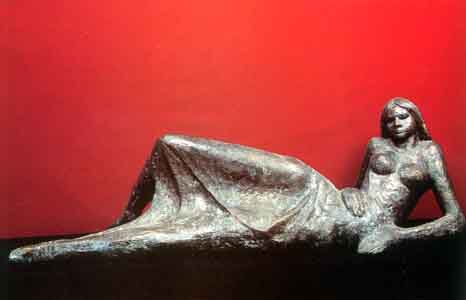 He was born in Kuwait Town in 1940 in modest family surrounding
He was born in Kuwait Town in 1940 in modest family surrounding
In 1960 he became one of the first young artists to join the
Free Government Atelier
soon after it was open, with him were -Abdulla Al Qassar, Khalifa Qattan,
Sami Mohammed, Qasaal Al Qaffas and others. Together they formed the nucleus
of the Art movement in Kuwait. From those days the Atelier became his favorite
place even when he settled down and got married, for he was spending more
time there than at his own home.
The place was provided with a library, material for painting and sculpture,
and teachers supervising and giving lessons, all free of change.
From the sculptor, Anuar Al Saroogi, Issa and his companions learned
the fundamental principles of sculpture ,and from the painters ,Hamed Hamaida
and Ahmed Al Warji, the principles of painting technique.
In
1961 Issa was the first artist to be sponsored by the Government.
In 1962 he was among the first group being sent to Egypt at the Art
Institute in Cairo. There his teacher, Jamal Alsigyni took a special interest
in him .At the end of his term Issa was awarded the prize of the
"Luxor Atelier- a four-years scholarship which he declined to return to
Kuwait where he was missing his family and friends.
In 1966 he was back with a diploma and his head full of lofty
dreams ,which were readily translated into beautiful sculptures in clay
,deep in philosophical thought .
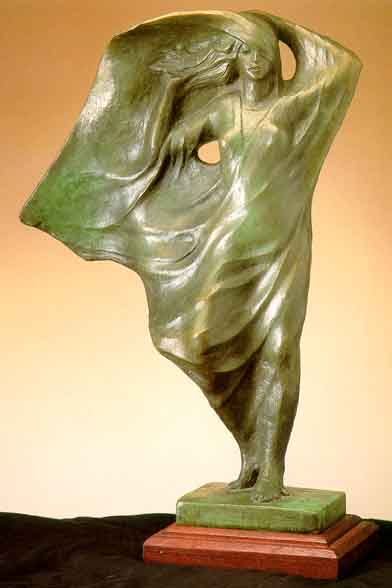 Unfortunately they were too complex to be easily cast in bronze later
he emerged with a style simple and congruous, full of human portent, comparatively
easier for casting .
Unfortunately they were too complex to be easily cast in bronze later
he emerged with a style simple and congruous, full of human portent, comparatively
easier for casting .
In 1967 Issa held his first personal exhibition ,in it most of his works
were philosophical ;they were the product of a highly creative mind
still glowing with the intellectual atmosphere of Cairo .
There was a kind of magic in some of his early works ,an intrinsic
value that promoted an eloquent response in anyone who could appreciate
the peculiar beauty and depth of their design .
In his second personal exhibition, of 1976 his style was changed considerably
,it was at once more direct in its communicative 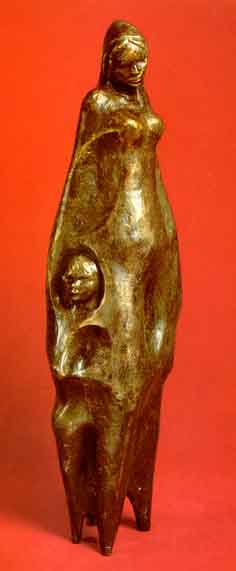 appeal; a true incarnation
of Nobel simplicity and strength derived from knowledge of human
nature ,of the habit of his people, the character of events and the
significance of arrested action . By eliminating the superfluous
and focusing the attention on the essential features of objects Issa
has brought forth an intensified vision of his objective.
appeal; a true incarnation
of Nobel simplicity and strength derived from knowledge of human
nature ,of the habit of his people, the character of events and the
significance of arrested action . By eliminating the superfluous
and focusing the attention on the essential features of objects Issa
has brought forth an intensified vision of his objective.
Happily married he could express his concept of woman in many beautiful
sculptures, and paintings ,in which the soul of woman is brought forth
in all its humanity and tender appeal with a touching charm of its own
.
Almost all his women are in bronze or clay , "Motherhood" is carved
in wood, and they all bear the nobility of expression, austere yet gentle,
of the typical Kuwaiti woman of the frugal past . The reliable companion
of man whose worthy example he found first in his mother, then in his wife
.
In his sculptures and paintings his human figures are solid
and permanently established ,yet plastic and free, the suggestion of freedom
being more emphatic in painting with their vaporous backgrounds of mystic
clouds and empty spaces
Since his return from Egypt (1966), and all through the seventies Issa
has been striving to improve his style both in painting and sculpture.
He joined numerous exhibitions in Kuwait and abroad and supervised on many
of them. He got three gold medals in the exhibitions sponsored
by the Kuwait Plastic Art Society of 1972 -74-75, and the "Golden
Sail" of the fourth "Arabian Artist’s Biennale "( the Kuwaiti Biennale
)in 1975 . He attended international conferences for sculptors in
Canada and Spain and the G.C.C. Cultural Week in Japan . In
the first Environment Exhibition , sponsored by the National Museum in
1987 he was awarded the Shield of honor .
In the fall of 1981 Issa Saqer was in the U.S.A. at the Jonson
Institute of New Jersey for a full course in bronze -casting. He was in
his early forty at the time ,but the enthusiasm and fire of youth had already
gone from him. Before he finished his training he had to return to Kuwait
because his mother was dying. That missed opportunity he for ever regretted
it.
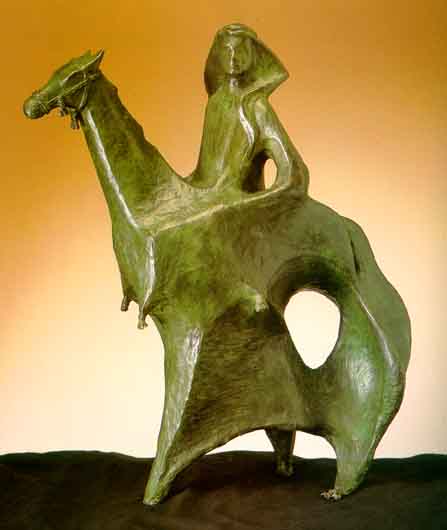 While he was at the Institute he learned to use his imagination on a
wider spectrum of interest and look at life in a different
perspective in which the essence of beauty is to delight the world, not
merely to express the artist’s feeling or emotions .
While he was at the Institute he learned to use his imagination on a
wider spectrum of interest and look at life in a different
perspective in which the essence of beauty is to delight the world, not
merely to express the artist’s feeling or emotions .
He also formed the habits of keener observations and quick response
to delicate expressions of subtle shades, and combinations of shapes, hues
and tones ,which is the basis of sound aesthetic education.
His contact with the outside world made Issa more keenly aware of the
social changes at home, which had been taking place since mid-seventies,
but only at his return he discovered the severity of the growing situation.
From then on a despairing apathy began to sink in his soul.
Ignored by the authorities the activity in the Free Atelier began to
wither. One by one Issa saw his companions leaving, at the end he was the
only one still practicing art there.
He remained faithful to the place that harbored so many happy memories
till a fateful illness set in . Seeking a cure he was sent to the U.S.A.
by the Kuwait government authorities but he died of it on the 20th
March 2000.
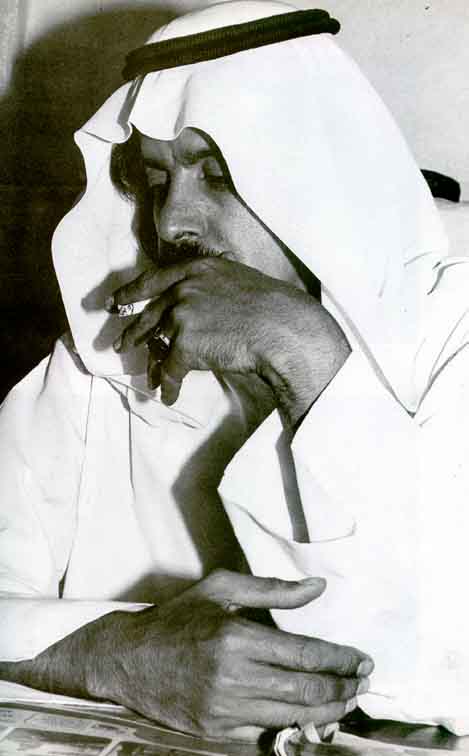
 He was born in Kuwait Town in 1940 in modest family surrounding
He was born in Kuwait Town in 1940 in modest family surrounding
 Unfortunately they were too complex to be easily cast in bronze later
he emerged with a style simple and congruous, full of human portent, comparatively
easier for casting .
Unfortunately they were too complex to be easily cast in bronze later
he emerged with a style simple and congruous, full of human portent, comparatively
easier for casting .
 appeal; a true incarnation
of Nobel simplicity and strength derived from knowledge of human
nature ,of the habit of his people, the character of events and the
significance of arrested action . By eliminating the superfluous
and focusing the attention on the essential features of objects Issa
has brought forth an intensified vision of his objective.
appeal; a true incarnation
of Nobel simplicity and strength derived from knowledge of human
nature ,of the habit of his people, the character of events and the
significance of arrested action . By eliminating the superfluous
and focusing the attention on the essential features of objects Issa
has brought forth an intensified vision of his objective.
 While he was at the Institute he learned to use his imagination on a
wider spectrum of interest and look at life in a different
perspective in which the essence of beauty is to delight the world, not
merely to express the artist’s feeling or emotions .
While he was at the Institute he learned to use his imagination on a
wider spectrum of interest and look at life in a different
perspective in which the essence of beauty is to delight the world, not
merely to express the artist’s feeling or emotions .